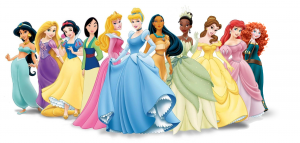 From Mav: There’s an article that appears in the textbook I use when teaching Freshman Composition 101 that I find quite fascinating. It’s called “Little girls or little women? The Disney princess effect” and was written by a woman named Stephanie Hanes in 2011 and is reprinted from the Christian Science Monitor. I use it to begin a conversation about the way in which we gender children. I actually don’t really care for Hanes’ argument. Her central thesis is that Disney Princess cartoons are essential a gateway into a series of problematic culture that we force onto young girls that result in the perpetuation of a sexist and patriarchal culture by lowering their self-esteem, turning them into sluts, and removing their ambition to succeed as adults beyond the desire to land a man. The base idea she’s working with is something that I think is important. My problem is that I question her logical progression of reasoning and causality. It goes something like this:
From Mav: There’s an article that appears in the textbook I use when teaching Freshman Composition 101 that I find quite fascinating. It’s called “Little girls or little women? The Disney princess effect” and was written by a woman named Stephanie Hanes in 2011 and is reprinted from the Christian Science Monitor. I use it to begin a conversation about the way in which we gender children. I actually don’t really care for Hanes’ argument. Her central thesis is that Disney Princess cartoons are essential a gateway into a series of problematic culture that we force onto young girls that result in the perpetuation of a sexist and patriarchal culture by lowering their self-esteem, turning them into sluts, and removing their ambition to succeed as adults beyond the desire to land a man. The base idea she’s working with is something that I think is important. My problem is that I question her logical progression of reasoning and causality. It goes something like this:
- First young girls like the Disney Princesses.
- Then they start liking Hannah Montana.
- Then they start wearing thong underwear.
- Then they start having sex.
- Then they get bad at math.
It feels like she’s making quite a few causal leaps that she hasn’t earned. There’s no real “proof” or anything that one step leads to another. While I acknowledge that Disney Princesses are popular, as was Hannah Montana (at the time) and thong underwear, and sex… she doesn’t really have anything that points to any one step along the way leading to any other. It just sort of “seems to make sense to her.” Even the final step in her proof is sort of problematic. Her line of thinking seems to stem from “a study” on sexualization of young girls. Side note from someone who teaches freshman comp for a living: NEVER just say “a study says…” CITE THE FUCKING STUDY! You know what it is… you read it… tell your reader so they don’t have to go looking for it (she sort of cites it, in that she links to a previous article that the Christian Science Monitor reported on the study… of course that article is gone now). Anyway, her claim is that “a study” shows that “a girl’s value as coming primarily from her sexual appeal…” and that “Sexualization, it reported, leads to lower cognitive performance and greater body dissatisfaction.” Her primary evidence being that “One study cited by the report, for instance, compared the ability of college-age women to solve math problems while trying on a sweater (alone in a dressing room) with that of those trying on swimsuits. Sweater wearers far outperformed the scantily dressed.”
So I tracked down “the study” and… it’s sort of true. She’s paraphrasing from “Report of the APA Task Force on the Sexualization of Girls” from 2007. The actual claim they make about the sweaters and swimsuits is that:
“One study demonstrated this fragmenting quite vividly (Fredrickson et al., 1998). While alone in a dressing room, college students were asked to try on and evaluate either a swimsuit or a sweater. While they waited for 10 minutes wearing the garment, they completed a math test. The results revealed that young women in swimsuits performed significantly worse on the math problems than did those wearing sweaters. No differences were found for young men. In other words, thinking about the body and comparing it to sexualized cultural ideals disrupted mental capacity.”
 Which is actually pretty different. They’re not saying that wearing swimsuits makes you bad at math. They’re saying that being asked to evaluate how you look in a swimsuit impairs your ability to do math at the same time. And… well, yeah… I imagine that’s true. I expect most women would be kind of annoyed if someone started asking them to solve quadratic equations while trying on bikinis. I bet they could have gotten the scores to go even lower if they’d asked the women to solve math problems in their underwear. Nothing makes you want to do lambda calculus like being half naked next to a dude in a lab coat with a clipboard. If anything, I’m actually kind of surprised that that it didn’t bother the male subjects.
Which is actually pretty different. They’re not saying that wearing swimsuits makes you bad at math. They’re saying that being asked to evaluate how you look in a swimsuit impairs your ability to do math at the same time. And… well, yeah… I imagine that’s true. I expect most women would be kind of annoyed if someone started asking them to solve quadratic equations while trying on bikinis. I bet they could have gotten the scores to go even lower if they’d asked the women to solve math problems in their underwear. Nothing makes you want to do lambda calculus like being half naked next to a dude in a lab coat with a clipboard. If anything, I’m actually kind of surprised that that it didn’t bother the male subjects.
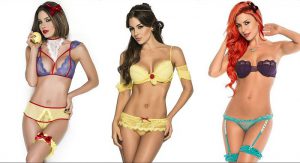 Hanes’ article is full of dubious claims like this. She similarly points to a statistic that “NPD Fashionworld reported in 2003 that more than $1.6 million is spent annually on thong underwear for 7-to-12-year-olds.” Of course, 2003, was basically the heyday of the thong (thanks Sisqo) and while that statistic certainly “sounds shocking” I suppose (think of the children!!!), it neglects to mention that that accounted for about 0.4% of underwear sales in that age group (as opposed to 40% for teens at that same time period). Scale certainly matters here. And, of course there’s nothing in her article that shows that your choice of underwear makes you more sexually active at any age. So, really it kind of just amounts to slut-shaming 7-year-olds for no apparent reason.
Hanes’ article is full of dubious claims like this. She similarly points to a statistic that “NPD Fashionworld reported in 2003 that more than $1.6 million is spent annually on thong underwear for 7-to-12-year-olds.” Of course, 2003, was basically the heyday of the thong (thanks Sisqo) and while that statistic certainly “sounds shocking” I suppose (think of the children!!!), it neglects to mention that that accounted for about 0.4% of underwear sales in that age group (as opposed to 40% for teens at that same time period). Scale certainly matters here. And, of course there’s nothing in her article that shows that your choice of underwear makes you more sexually active at any age. So, really it kind of just amounts to slut-shaming 7-year-olds for no apparent reason.
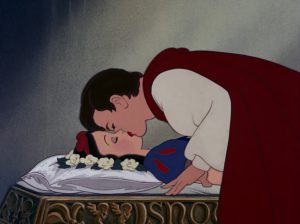 That said, I do think the issue that she’s trying to highlight shows some merit and is worth discussion (it’s why I use the article in my classes in the first place). There’s no shortage of think pieces written that worry that the gender norms encoded in the Disney Princess stories might be problematic and harmful to the intended audience. There’s also a lot written about the problematic way Disney has dealt with sexual consent in many of their classic stories (hey look, there’s a 14-year-old girl in a coma… I’m totally gonna hit that!) Even in my dissertation research I’ve been looking at the way in which sexuality is encoded in children narratives, and have been pretty fascinated by the argument that Jewett and Lawrence make in The Myth of the American Superhero about how Disney treats sex differently with their human vs. non-human characters (they actually believe the animals are more sexual).
That said, I do think the issue that she’s trying to highlight shows some merit and is worth discussion (it’s why I use the article in my classes in the first place). There’s no shortage of think pieces written that worry that the gender norms encoded in the Disney Princess stories might be problematic and harmful to the intended audience. There’s also a lot written about the problematic way Disney has dealt with sexual consent in many of their classic stories (hey look, there’s a 14-year-old girl in a coma… I’m totally gonna hit that!) Even in my dissertation research I’ve been looking at the way in which sexuality is encoded in children narratives, and have been pretty fascinated by the argument that Jewett and Lawrence make in The Myth of the American Superhero about how Disney treats sex differently with their human vs. non-human characters (they actually believe the animals are more sexual).
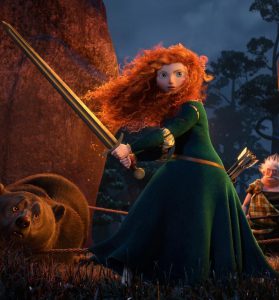 I think there is something to that. Certainly there’s issues with the way girls in Snow White and Sleeping Beauty were gendered as sexual objects… issues that Disney has tried to reverse with many of their later Princess stories like Brave and Frozen. And of course, there’s something to be said for the way the cartoons lean heavily towards making the girls pretty… though I don’t think that’s as cut and dry… in a capitalist system, mass media will always lean into the conventionally attractive because doing so sells better than not… and while media does have a hand in constructing the ideals of attractiveness, the chicken and egg problem that this represents is probably a different topic entirely.
I think there is something to that. Certainly there’s issues with the way girls in Snow White and Sleeping Beauty were gendered as sexual objects… issues that Disney has tried to reverse with many of their later Princess stories like Brave and Frozen. And of course, there’s something to be said for the way the cartoons lean heavily towards making the girls pretty… though I don’t think that’s as cut and dry… in a capitalist system, mass media will always lean into the conventionally attractive because doing so sells better than not… and while media does have a hand in constructing the ideals of attractiveness, the chicken and egg problem that this represents is probably a different topic entirely.
 But also, I’m wondering how much of the Disney Princess canon is actually as sexualized as we make it out to be, versus how much of it extra-textual information added by the fandom and conflated with the base narrative. That is to say, the fact that Snow White and Aurora are sexually assaulted in their sleep and it’s written as a “good thing” is canon. However, a lot of our ideals abut the sexuality of Elsa or Cinderella come as much from cosplay and fanfic and general groupthink of a massive fandom that has fetishized them in both the sexual and Marxist senses.
But also, I’m wondering how much of the Disney Princess canon is actually as sexualized as we make it out to be, versus how much of it extra-textual information added by the fandom and conflated with the base narrative. That is to say, the fact that Snow White and Aurora are sexually assaulted in their sleep and it’s written as a “good thing” is canon. However, a lot of our ideals abut the sexuality of Elsa or Cinderella come as much from cosplay and fanfic and general groupthink of a massive fandom that has fetishized them in both the sexual and Marxist senses.
 Because they have been so popular for so long, they have naturally seeped into the zeitgeist and therefore become a part of American culture as a whole for those who grew up with them. Like we talked about back on the She-ra episode, a lot of the male gaze hyper-sexualization that we attribute to the original show, wasn’t actually there, even though it exists in the cultural memory as though it did. The princesses are cultural touchstones (even more so than She-ra). And because sex is so important to us as a culture (while at the same time, being verboten, especially in connection with children or childish things) we take exceptional notice when that cultural touchstone is mixed with something sexual, like imagining the Disney Princesses in 50 Shades of Grey, or starting a line of sexy lingerie based on them.
Because they have been so popular for so long, they have naturally seeped into the zeitgeist and therefore become a part of American culture as a whole for those who grew up with them. Like we talked about back on the She-ra episode, a lot of the male gaze hyper-sexualization that we attribute to the original show, wasn’t actually there, even though it exists in the cultural memory as though it did. The princesses are cultural touchstones (even more so than She-ra). And because sex is so important to us as a culture (while at the same time, being verboten, especially in connection with children or childish things) we take exceptional notice when that cultural touchstone is mixed with something sexual, like imagining the Disney Princesses in 50 Shades of Grey, or starting a line of sexy lingerie based on them.
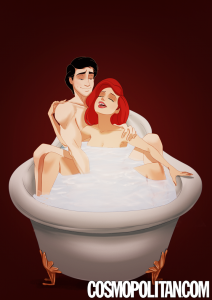 So that’s what I want to explore here. How much sex is there really in these stories? Obviously, as all-ages G-rated family cartoons, the explicit sexualization of the characters is pretty downplayed; there’s no steamy Cinemax-style sex scenes. But it would be disingenuous to ignore the sexual undertones of something like The Little Mermaid, not only because of the way she dresses, but because a large portion of the narrative is essentially surrounding Ariel’s conflict with Ursula over who can bed Prince Eric first (kiss… yeah… right). Furthermore, I’m wondering in what ways is this actually problematic? Certainly there are issues with the older films like Snow White and Sleeping Beauty, but how pervasive is this across the entire body of work and are there any good points that come from it as well?
So that’s what I want to explore here. How much sex is there really in these stories? Obviously, as all-ages G-rated family cartoons, the explicit sexualization of the characters is pretty downplayed; there’s no steamy Cinemax-style sex scenes. But it would be disingenuous to ignore the sexual undertones of something like The Little Mermaid, not only because of the way she dresses, but because a large portion of the narrative is essentially surrounding Ariel’s conflict with Ursula over who can bed Prince Eric first (kiss… yeah… right). Furthermore, I’m wondering in what ways is this actually problematic? Certainly there are issues with the older films like Snow White and Sleeping Beauty, but how pervasive is this across the entire body of work and are there any good points that come from it as well?
As always we are curious to your thoughts and whatever other important issues (positive or negative) you see with these films that we should discuss.

When I was a young reader I alway looked for books that involved girls and women solving/ building/ or accomplishing things. I got flustered with romantic drama and girlfriend squabbles. I liked Kim Possible, Anne McCafrey, and the Little House books. There are many pulp Fantasies wear man and woman come to love each other after winning a war together, or love each other as friends. These are themes that are sorely missing today.
I use this article in one of my comp classes, too. I agree that it’s not the best, but it’s usually useful for sparking a discussion. (Though I am often surprised at the number of students who shrug off the idea that what we see over and over in the media (any type of image or stereotype or trope) or hear repeatedly from our family and friends can have an effect.)
I tend to think of the more recent movies as having more sexual overtones, but I wonder how much of that is just being older and seeing more possibilities with the characters and situations. In order to see these things as more sexual, don’t we have to have a frame of reference for that? So an 8 year old might not get the full impact of the adult Nala and Simba wrestling, but adults think “damn – how did they give an animated lion bedroom eyes like that?”
And I admit, I do take perverse delight in telling them what the original story of the little mermaid was.